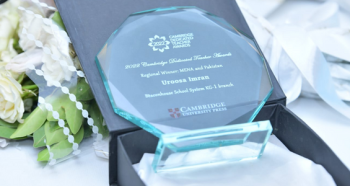I was recently asked a tricky question in a workshop I was running: ”Surely you can’t be really advocating creativity? You work at an exam board!”
Creativity and high stakes examinations are not topics that we usually think about as being related. Professor Melvin Tumin, a Princeton sociologist sums it up by saying, ”Nothing is quite so hostile to the maximization of creativity as the competitive grading system which prevails in our schools”.
In my previous blog post I wondered whether we should take a wider view of creativity: could we include more creative activity in our lessons and still cover the syllabus in time for the exam?
Well, what if developing our learners’ creative thinking skills could in fact help them perform better in an exam?
Aiming high
Under pressure from school and parents to get top grades, it’s easy to feel that we’ve just got to ”get through” the syllabus and help our learners to remember as much content as possible. However, to be successful in exams, it is vital to have skills such as judgement and decision making, and to be able to apply these to unfamiliar subject matter.
Creative thinking is also high order thinking. Many of us are familiar with the revised Bloom’s Taxonomy in
which creativity is rated at the highest level. If we regularly encourage students to aim towards the top of the pyramid, might it help them make more progress in work that focuses on the equally important categories lower down, many of which also feature in high stakes exams?
Let’s take a couple of comparisons from the world of sport.
- Many runners train at high altitude in preparation for the marathon so that when they run the real race at a lower altitude it feels easier.
- Speaking at a recent Cambridge Schools Conference, Matthew Syed, the former international table tennis player, described how his coach, Chen Xinhua, made things more challenging for him. Xinhua widened Syed’s end of the table by 50% to force him to increase his movement, speed and positional awareness. It also hugely increased his success and world ranking.
Teaching creatively
Teachers are some of the most creative people on the planet. How else could they turn a syllabus document into interactive, exciting and inspiring lessons every day of the week?
As teachers we need to have the confidence to be creative with our lessons. Creativity can be an intrinsic part of many lessons, instead of being limited to art lessons or after-school activities. Creative activities stimulate active learning. There is always a creative way to do something, and preparing for exams is no different.
What if it isn’t exams that are destroying learners’ creativity? What if it is actually the way we are teaching that is the problem?
”Teachers have (often) interpreted the curriculum in a very prescriptive way. They haven’t always taken advantage of the flexibility that is available to them. They can bring back their own judgement and develop the children’s creative thinking behaviour as part of the national curriculum.” – Margaret Talboys, QCA Programme Leader, United Kingdom
In their revision of Bloom’s Taxonomy, Lorin Anerson and David Krathwohl (2001) described how meaningful learning or ”transfer” only occurs when a learner is able to make sense of and use what they know in unfamiliar contexts.
Looking at a topic from different perspectives is one example of a creative thinking skill. This will help a learner to balance an argument effectively in an essay, a skill which will be rewarded in an exam.
Harvard Project Zero’s Artful Thinking project offers ideas for thinking routines such as ”Perceive, know, care about”. This is a short discussion-based exercise that uses artworks or photographs of people to prompt learners to think about a situation from another person’s point of view.
Thinking metaphorically is a high order thinking skill that can be used in any subject. Asking questions such as, ”if carbon were a person, what qualities would she/he have?” might trigger some interesting insights into a learner’s understanding.
You can even be creative if you teach Maths!
”I ask my high achieving students to make videos and poems to express their mathematical abilities” – Siti Zaleha, Head of Maths, HELP International School, Kuala Lumpur
What to know more?
Harvard Project Zero’s Artful Thinking resources
Harvard Project Zero: cross-curricular visible thinking routines
Video: the case for creativity in primary school
Wild Maths is a collection of mathematical games, activities and stories, encouraging you to think creatively.
Destination Imagination: For hands-on learning through creativity challenges in STEAM subjects (Science, Technology, Engineering, Arts and Maths).
C.J. Simister’s book, ”The Bright Stuff” is full of ideas about how to bring creativity into your classroom.
And don’t forget that ”innovative” is one of our Cambridge Learner Attributes.





